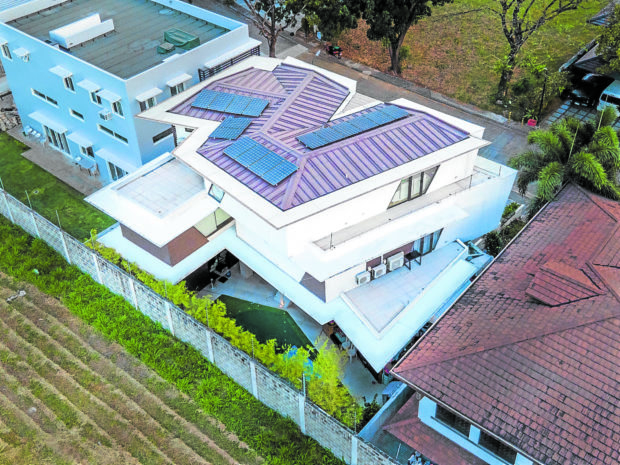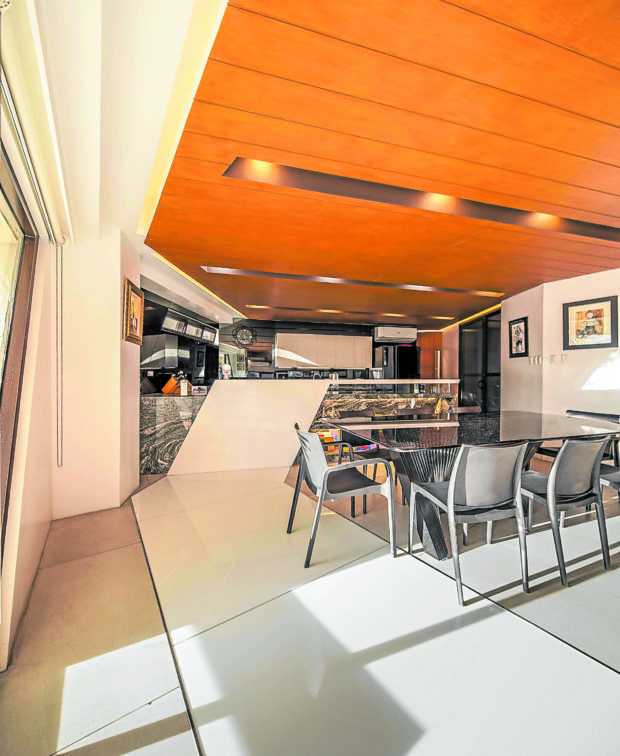
Architect John Patrick Anthony “Jason” Buensalido’s projects are not for the shy. His structures make a powerful visual impact for their bold, at times surreal, silhouettes.
The Shift House, a stack of V-shaped volumes, not only defies the conventional Modernist box-like buildings in this neighborhood in the Metro South. The design has turned out to be pandemic-ready.
Why a massing of V-shaped floors? The clients, a couple with three young children, wanted a house with lots of spaces, but they also needed some privacy. The challenge was how to fulfill those requirements given a compact square lot under 500-square meters and the village height restrictions of 10 meters—the equivalent of three stories and a roof.
The advantage of a V-shaped plan is that the two branches isolate the rooms from each other, thus providing the discretion. “When the rooms are tilted apart, you won’t hear or see each other,” says Buensalido. In a normal plan, when two rooms are adjacent, you can see each other and hear the noise in the next room.
As a gateless subdivision, the houses are not allowed to put up front fences in order to establish a welcoming presence and to build a sense of community.
Private and public spaces
Collaborating with lead architect Marcelo Philippe Ramirez, Buensalido designed a four-level home. The underground basement follows a V-shaped footprint with one arm serving as the carport while the other is the service wing.
To provide privacy on the ground floor without a front fence, there are fewer windows on the facade, but more openings on the sides and back. The central body of the V-plan is the front porch.

“It becomes a tool for community building. Since it is wide, you tend to stay longer, there are more opportunities to say hi to your neighbors,” says Buensalido.
Away from the street, the two wings create arms shaped like a “V” for the living room and dining room, show kitchen and working kitchen. These areas are directed toward the garden at the back.
“Since there is no fence to cover up the front from the public, we created an inward-looking house on the ground level,” he explains.
On the second floor, the V-shaped plan is oriented toward the street. The wings naturally separate the master bedroom and the guest room in different orientations while the family hall is at the midpoint of the V.
Although the facade of the master bedroom faces the road, a big window overlooks the canopy of trees, adding a layer of privacy. The guest bedroom, on the other hand, looks out into the garden. Thus, each wing contains one room with three windows that allow cross-ventilation for more flow of air and natural light.
The architect explains that the V plan on the third level has been moved sideways, creating the roof-deck and balcony. Each branch holds a room for the children. They converge at the open, multipurpose hall for study and play.
“The V-shaped floors were stacked to add volume to the design. The floors were shifted against each other to come up with a dynamic form. We identified the openings on the upper floors for the views, light and ventilation and came up with easy accesses to the outdoors and nature. These features have been appreciated especially after being cooped up in lockdowns,” explains Buensalido.
Open spaces
The color scheme of the exterior is pure white, softened by the warmth of woods, to emphasize the main design element, the massing of the V-shaped floors.
Inside the house, the bedroom floors are covered with weather-resistant engineered wood while tiles and stone are set on the ground floor. The staircase is made with narra, lined with powder-coated steel railings and glass.
The wooden linear strips on the ceiling add intimacy to the space. As these planks run parallel to the V layout, their lines lead the eyes to the outside views, says Buensalido. Lighting is hidden under recessed wooden strips to eliminate glare and to create a homey mood at night.
The architect likes to blur boundaries between surfaces by creating continuous architectural strips. In the kitchen, a uniform color of the decorative strip runs from the wall, counter and floor, resulting in a flowing movement. The same look applies in the bedroom where the headboard wraps around the ceiling. “When details are unified, everything looks more organized,” says Buensalido.
The clients said it was a good decision to approve the V-shaped design, which resulted in balconies and open spaces.
“These were sources of sanity,” Buensalido says. “During the lockdowns, there is contact with nature at every level—the roof deck on the third floor, a garden at the back, balconies on each floor. These become quick respites for them in the middle of the day. The kids can do their remote learning in the family hall. You don’t feel confined even if you stay inside for the entire day.” —CONTRIBUTED INQ


